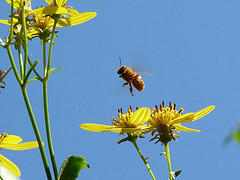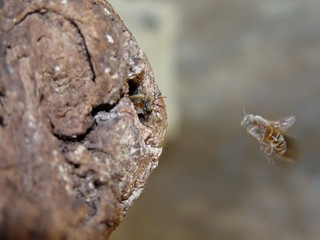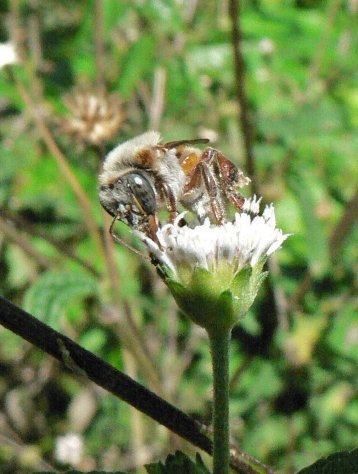
Adaptation
Melipona
beecheii are members of the Melipona genus, which consists of
stingless bees. Stingless bees no longer have a functional sting
at the end of the abdomen. They also are eusocial and produce
honey. The bee has compound eyes and hair on the majority of its
body and its six legs. (EOL 2013). Melipona beecheii has an
exoskeleton as well as internal muscles like other insects and
bees (Snodgrass 1956)
Honeybees
have two sets of membranous wings, with the front set being
larger than the hind set. The two sets work together, and so
they are linked to make sure the motion is smooth. The links are
actually hooks, and the wings are not linked
in the resting position. The hooks can vary in shape between the
different classes, such as workers or drones, that can affect
their flight ability (Snodgrass 1956).

Melipona beecheii follow the lifecycle of other honeybees in
which they hatch from eggs as larvae and then pupate into adults
(EOL 2013). The bee larva looks almost nothing like an adult,
and in the pupal stage it is nearly completely reconstructed.
The larvae is adapted to live in the hive, so it has mouth parts
but no antennae, functional legs, external wings or eyes.
(Snodgrass 1956) Bees have a caste system of drones, queens and
workers, where drones are males and the rest are females. The
responsibilities do not overlap between the classes except in
special circumstances the workers can make eggs as well as the
queens. The queen gains developed ovaries but loses certain
worker aspects such as food glands, pollen carrying hind legs,
and specialized mandibles. The colony with the entire caste put
together is biologically entity, where the different organisms
can be seen as specialized organs or cells in part of a whole
(Snodgrass 1956) It is expressed elsewhere that a honey bee hive
resembles an organism more than any of the individuals do.
(Gould and Gould 1988).
Pollen is
the main protein source in honeybees, and is carried in
the hind legs mostly. Bees usually end up covered in pollen from
their experience with flowers, but when they are particularly
looking to take it back to the hive they use specialized
compartments in their legs. These compartments are called
corbiculae, and the pollen is scraped off with the middle legs
once back in the hive. (Snodgrass 1956)

Honeybees, and in turn
Melipona beecheii are eusocial insects.
This means that they can communicate with each other and have
determined roles in their society. The main form of
communication between bees is through pheromones and odors.
(Gould and Gould 1988) This is supported in a study by Dr. James
C. Neigh that examined a different genus of Melipona and found
that they could relay to their peers a food source’s direction,
distance and elevation. While it has been shown that smell is a
large part of bee communication, this study in particular showed
that smell wasn’t necessary to communicate. (Niegh and Roubik
1995) Bees can communicate using sound by using their wing
muscles while the wings themselves are folded. This in turn
causes a buzz noise instead of lift (Gould and Gould 1988)
It has been speculated that the honeybee’s communication
system is second in complexity only to our own, and greatly
helps honeybees keep track of food. Bees use a number of ways to
gauge where food is, and one way is energy expended. This was
found by putting pieces of foil on a bee, and it turned out that
the bees that communicated with those with the extra air resistance created by the tin foil were frequently overshooting
their target. (Gould and Gould 1988).